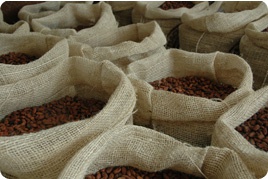- Home - News
- TWI News | TV
- Polls
- Year In Review
- News Archive
- Crime & Punishment
- Politics
- Regional
- Editorial
- Health
- Ghanaians Abroad
- Tabloid
- Africa
- Religion
- Election 2020
- Coronavirus
- News Videos | TV
- Photo Archives
- News Headlines
- Press Release
Business News of Tuesday, 23 December 2014
Source: BlackSeaGrain/GB
Waning Ebola fears cast doubt on cocoa price rises

The bounce in cocoa prices from mid-November lows may not prove sustainable, as a hangover from stockpiling by processors comes into play by depressing demand, influential analyst Judith Ganes-Chase said.
Cocoa futures for March have recovered more than four per cent since, a month ago, hitting a five-month low in London of £1,844 a tonne, and a nine-month low in New York, of US$2,780 a tonne.
The revival has been spurred by concerns that cocoa production in Ghana and Ivory Coast, the top two producing countries, may disappoint in 2014-15, with trees too fatigued by last season’s bumper harvests to repeat the performance.
However, demand may miss expectations too, as the retreat in concerns over the spread of Ebola in West Africa, a region responsible for most of world cocoa production, allows processors to run down stocks built up as disease worries were growing over the summer.
‘Void of physical interest’
“Now that the fear subsided, it becomes a bearish element” for cocoa prices, Ms Ganes-Chase, head of J Ganes Consulting, said.
It leaves prices – which is London remain 10 per cent below their September high, and in New York are down 13 per cent – “vulnerable to a further spill, as those that bought forward aggressively no longer have the need to shore-up stocks”.
Indeed, the market will suffer a “void of physical interest going forward”, she said, foreseeing a “marked slowdown in demand growth” ahead.
“It is rare that cocoa grind actually declines and with the global economy gaining moderately I would not expect a slump.
“However, with some countries potentially facing economic uncertainty once again, any revival in demand is bound to be limited.”
‘Slowdown in the grind’
As an extra setback, an upgrade two weeks ago of 12,000 tonnes, to 430,000 tonnes, by the International Cocoa Organisation to its estimate for North American cocoa processing volumes may have been unwarranted.
Improvements in reported North American grinding volumes, which rose 4.6 per cent year-on-year in the July-to-September quarter, were fuelled by “buy-ins ahead of announced price hikes… by major manufacturers”.
The fallout could be a “slowdown in the grind for the fourth quarter, if not longer”, Ms Ganes-Chase said.
And, as an extra concern, a correction in the unusually high ratio between prices of cocoa butter and cocoa powder, the two main products of processing beans, was undermining grinding margins.
Cocoa prices may “unravel even further, absent any new worries about production prospects”.










